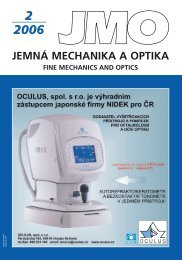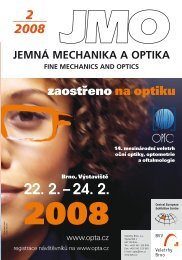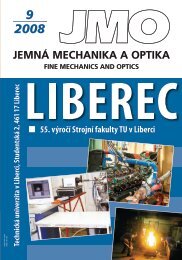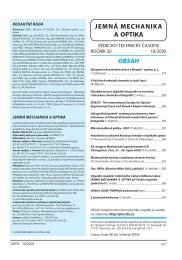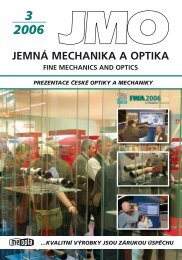technická univerzita v liberci fakulta strojní - Jemná mechanika a ...
technická univerzita v liberci fakulta strojní - Jemná mechanika a ...
technická univerzita v liberci fakulta strojní - Jemná mechanika a ...
You also want an ePaper? Increase the reach of your titles
YUMPU automatically turns print PDFs into web optimized ePapers that Google loves.
3/2007<br />
Fig. 3c<br />
Fig. 3 SEM image of carbon fiber: a) untreated sized; b) argon<br />
plasma for 10 minutes, the flash-marked shows increased the superficial<br />
roughness; and c) oxygen plasma for 2 minutes<br />
indicates that the roughness introduced on the fiber’s surface by the<br />
argon plasma treatment did not negatively affect this mechanical<br />
property. On the contrary, these samples displayed significantly<br />
higher tensile strength values. The fiber treated with oxygen<br />
plasma (Figure 3c) displayed su perficial morphological changes<br />
quite similar to those produced by the argon plasma treatment, and<br />
a striated pattern was observed along the fiber’s axis. In this case,<br />
the striation depth was found slightly deeper than that observed in<br />
the argon plasma-treated fiber.<br />
4. CONCLUSIONS<br />
In this work, for surface modification of PAN-based carbon<br />
fibers plasma surface treatment involved cold argon and oxygen<br />
plasma methods were carried out here. The results from SEM<br />
observation revealed that the carbon fibers treated with argon and<br />
oxygen plasma showed depth striations. The oxygen plasma method<br />
resulted in the removal of carbon atoms in the form of CO and CO 2<br />
instead of increasing the number of polar groups on the carbon<br />
fiber surface. The results obtained from SEM investigation of the<br />
carbon fiber treated with argon plasma for 10 minutes, indicate that<br />
the argon plasma treatment increased the superficial roughness.<br />
A comparison of the SEM findings and the tensile strength results<br />
indicates that the roughness introduced on the fiber’s surface by the<br />
argon plasma treatment did not negatively affect this mechanical<br />
property. On the contrary, these samples displayed significantly<br />
higher tensile strength values. Finally, it can be conclude that cold<br />
plasma (argon gas flow) treatment may improve reliably the roughness<br />
and fine mechanical properties of carbon fibers.<br />
Acknowledgments<br />
This work was supported by the postdoctoral research grant of<br />
the Danish Framework Programme “Interface Design of Composite<br />
Materials” (STVF fund no. 26-03-0160). In particular, first author<br />
gratefully acknowledge Dr. B. F. Sorensen for his continuing interest<br />
and technical support in this work. Thanks are also due to<br />
Dr. J. B. Sorensen of the laboratory of the electron microscopy of<br />
Materials Department, Risø National Laboratory for preparing the<br />
samples and assistance during SEM examination.<br />
References<br />
[1] Johnson, D. J., Structure and properties of carbon fibres.<br />
In Carbon Fibers Filaments and Composites, ed. J. L.<br />
Figueiredo, C. A. Bernardo, R. T. K. Baker & K. J. Hüttinger.<br />
Kluwer Academic, The Netherlands, 1990, pp. 119-146.<br />
[2] Diefendorf, R. J., and E. W. Tokarsky, Polymer Eng. Sci.,<br />
15, 150 (1975).<br />
[3] Zielke, U., Hüttinger, K. J., Hoffman, W. P., Surface-oxidized<br />
carbon fibers: I. surface structure and chemistry. Carbon.<br />
1996; 34(8):983-998.<br />
[4] Hull, D., Clyne, T. W.: An introduction to composite materials.<br />
2nd edition. Melbourne: Cambridge University Press; 1996.<br />
[5] Fujimaki, H., et al. Process for the surface treatment of carbon<br />
fibers. U.S. patent. 4,009,305, 1977.<br />
[6] Yue Z. R., Jiang W., Wang L., Gardner S. D., Pittman Jr. C.<br />
U. Surface char acterization of electrochemically oxidized<br />
carbon fibers. Carbon. 1999; 37(11):1785-1796.<br />
[7] Li Rongzhi, Ye Lin, Mai Y. W. Application of plasma technologies<br />
in fibre-reinforced polymer composites: a review of<br />
recent develop ments. Composites Part A: Applied Science<br />
and Manufacturing. 1997; 28(1):73-86.<br />
[8] ASTM Standard test method for tensile strength and young’s<br />
modulus for high-modulus single-filament materials. Philadelphia,<br />
PA: ASTM, 1982 (ASTM D 3379-75).<br />
[9] Rashkovan I. A., Korabel’nikov Yu. G. The effect of fiber surface<br />
treatment on its strength and adhesion to the matrix. Composites<br />
Science and Technology. 1997; 57(8):1017-1022.<br />
[10] Jenkins G. M. , Kawamura K. Polymeric carbons: carbon<br />
fibre, glass and char. 1st edition. Cambridge University Press:<br />
Cambridge, 1976.<br />
*Hamid Sarraf a,b , Petr Louda b<br />
a Danish Polymer Centre, Risø National Laboratory, Frederiksborg vej 399, P.O. 49, DK-4000, Roskilde, Denmark<br />
b Faculty of Mechanical Engineering, Technical University of Liberec, Hálkova 6, 461 17 Liberec 1, Czech Republic<br />
*Corresponding author, e-mail address: sarraf_20002000@yahoo.com<br />
73



